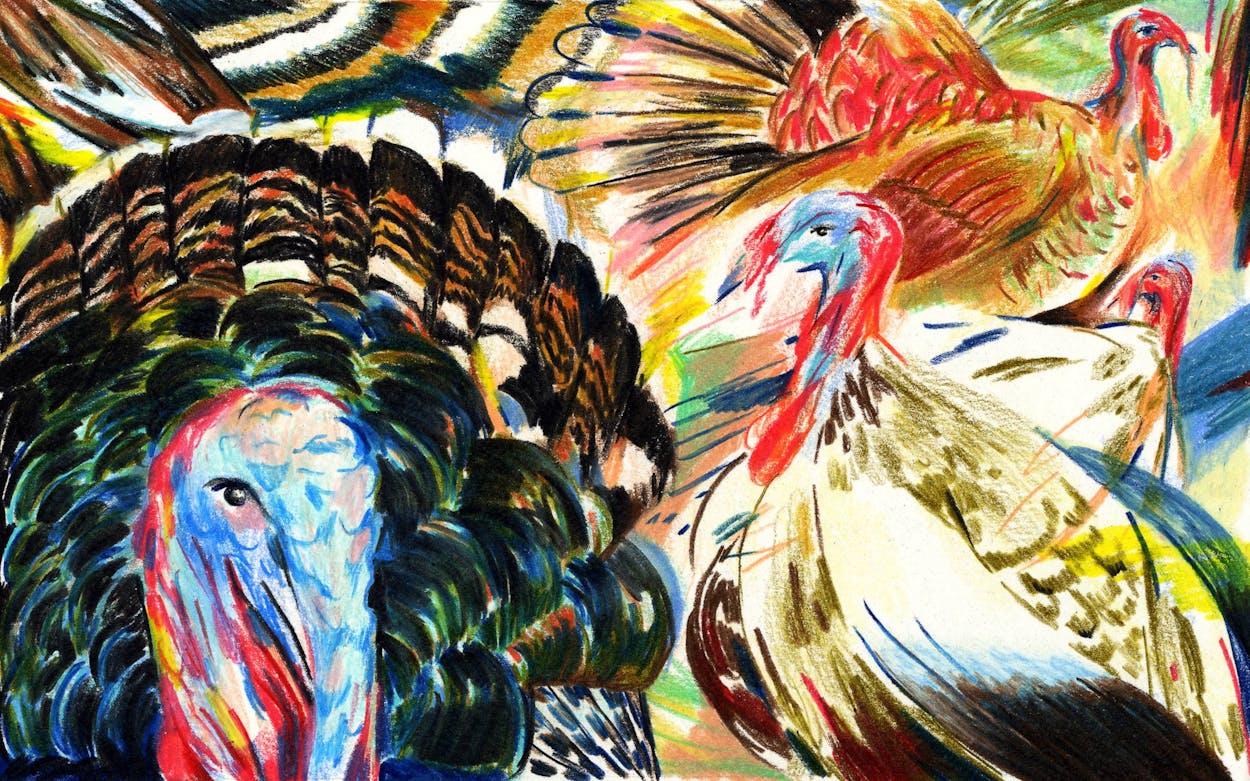“Whatever you do, don’t let go of the legs.” These words of warning, delivered sternly by a seasoned rancher, didn’t seem necessary at first. I was standing in a sunny patch of pasture at Roam Ranch, a nine-hundred-acre paradise along the Pedernales River just east of Fredericksburg, holding a very calm and quiet turkey. A twelve-pound tom with ample black-and-gray plumage, the bird emitted the occasional soft gobble but did not move. I looked into its beady black eyes and said, feeling foolish and more than a little nervous, “Thanks for your life, turkey. And, uh, I’m really sorry for what I’m about to do.” Then I lifted it into the air, tail first, and immediately understood the advice about the legs. The turkey flapped its wings wildly, yelping and thrashing its body against mine in a flurry of feathers and dust. I held on, but barely. “You’ve got a live one!” my instructor laughed. Together we hoisted the animal upside down into a metal cone, mounted on the side of a livestock trailer, where it would meet its end. The bird became suddenly still again, with only its head and neck protruding from the narrow bottom of the cone.
As instructed, I pointed a bolt gun directly between the eyes and fired it, killing the turkey instantly. Next came the most intense part: slitting the throat with a paring knife, then draining the blood. As an impressive quantity of hot, steaming red liquid poured over my bare hands and splattered my Chuck Taylors (this would later take quite a bit of scrubbing to remove), I watched a little girl, maybe four years old, a few feet away. She was playing in a puddle of congealed gore from the other turkeys that had already been dispatched. “Look at all dis blood!” she squealed happily. This is one of the weirder things I’ve ever done for a story, I thought. How did I, a strict vegetarian for most of my life, end up here?
I felt less befuddled when Taylor Collins, a lifelong Texan who co-owns Roam Ranch with his wife, Katie Forrest, admitted he’d come a long way too. “We used to be vegans,” he said, “so it’s been a journey.” The pair competed in triathlons and endurance cycling races, but they eventually found that their bodies couldn’t recover without more protein. They switched to a paleo-influenced diet, emphasizing lean meats, and found it so transformative that they started a company, Epic Provisions, to make jerky bars and other protein snacks. After selling Epic to General Mills in 2016, they used some of the money for their next adventure: starting a ranch in the Hill Country. At Roam Ranch, they raise free-range bison, turkey, deer, ducks, pigs, goats, and more and sell the high-quality meat under the brand Force of Nature. The couple also welcomes about two thousand guests per year to the property for an array of workshops. This year’s turkey harvest was the fourth-annual Thanksgiving event to sell out; you can also stop by to learn the art of tanning deer hides or watch baby bison take their first steps. “We have a reverence for animals and the land,” Collins says, “and a respect for nature and wanting to do the right thing.”
That much was obvious when I visited the sprawling pasture where the family’s flock of about four hundred heritage-breed turkeys roam free, eating bugs and seeds. As an inquisitive hen pecked at my shoelaces, Force of Nature’s community manager, Morgan Weeks, explained the basics of regenerative agriculture, the sustainable philosophy that the company embraces. Most big commercial farms focus on one crop or animal at a time, which depletes the soil of nutrients and otherwise throws the ecosystem out of whack. “It’s amazing how balanced Mother Nature is,” Weeks said. “We try to do it her way, not the conventional way.” That brings challenges not present at factory farms, where turkeys spend their lives crowded into indoor pens. This year, the Roam team lost sixty or so of their turkeys to great horned owls. (They placed strobe lights to scare off the predators at night, with mixed success.) Pitfalls like these must be factored into the high price tag of sustainable meat; a family ticket to the Roam turkey harvest, which includes instruction and a tour, is $150. But there are also benefits to raising animals sustainably: the turkeys share pasture space with the bison, and the birds eat insects from bison dung, which helps keep all the animals and the soil healthy. And, of course, everyone swears the meat tastes better, though I had yet to find that out firsthand.
At times, the experience did feel a lot like a Portlandia episode—though, thank goodness, none of the turkeys had names. Collins and Forrest encouraged us to thank our turkeys for their sacrifice, and each group did this quietly and without much fuss. My husband, Chris (who’d come along for the ride), and I joined a group of about thirty families in packing the meat into our Priuses and Teslas to take home to Austin. If you’re rolling your eyes, I don’t blame you. Most Texans can’t afford this lifestyle. But if you can, maybe you should try it. Every time you eat meat, you’re indirectly pulling the trigger. Being the one to literally do it, even if just this once, was an experience I will never forget. It was sad and sobering and exhilarating, messy and smelly and fun. Each time I plunged my arm into the turkey to scoop out its still-steaming organs, my hand emerged with a new surprise: There was the gizzard, full of pebbles and grit. There were the liver, the spongy lungs, the coiled intestines, the perfectly shaped heart. I know this sounds gross, and it absolutely was, but it was also extremely cool. Animal bodies are miraculous feats of nature; it’s easy to forget that if you do most of your hunting at H-E-B.
Back home, the work had just begun. The idea of cooking the turkey was actually much more intimidating than the murdering bit. I grew up in a vegetarian household and still don’t quite consider myself a carnivore. Until I met my husband in Houston a decade ago, I ate veggie lasagna at most Thanksgivings with my Bernie-voting, organic-gardening, composting toilet–building extended family in Ohio. Sometimes for dessert we had chocolate tofu pie that my vegan cousins had made (don’t knock it till you try it). During the years we stayed home in Pennsylvania for the holiday, my English-professor parents would invite their international students, who brought all manner of dishes from their home countries; I was especially fond of the stuffed grape leaves that Motasim, from Jordan, would make.
I abandoned vegetarianism in college, when a semester in Buenos Aires broke me—need I say anything about the succulence of Argentine beef?—but Chris and I still eat a mostly plant-based diet at home. His parents usually host Thanksgiving and cook a Costco turkey. I have nothing against Costco, but I must admit that almost every time I’ve eaten turkey, I’ve been unimpressed. It usually tastes like . . . well, nothing, a blank slate so bland that one has to smother it in gravy and cranberry sauce in order to stay awake at the table. I had no idea how my heritage turkey would compare. I didn’t own any of the right kitchen equipment, and a quick Google search for recipes left me overwhelmed. Should I do a wet or dry brine? How much basting was involved, and would I need to spatchcock?
In the end, I chose an America’s Test Kitchen recipe for a roast heritage bird. (Heritage-breed turkeys are smaller and leaner than their Butterball brethren and thus cook differently.) The only ingredient other than the turkey was salt, which I rubbed all over and under the skin 24 hours before cooking. I was tempted to switch to a more complicated recipe with herbs and onions, but laziness won out. The next day, we roasted the bird at 250 degrees for about four hours, periodically poking it with a meat thermometer. That oven temperature seemed almost alarmingly low, but I know from the work of Texas Monthly’s barbecue editor, Daniel Vaughn, that cooking low and slow makes for great barbecue; maybe the same principle applies to turkey. The kitchen filled with a tantalizing aroma as our guests arrived, and Chris whipped up a bowl of Samin Nosrat’s fried-sage salsa verde to serve alongside the gravy and stuffing. I arranged the turkey’s striped feathers, which we had plucked unceremoniously from its still-twitching tail minutes after its demise, in a mason jar on the table as a centerpiece.
Then came the moment of truth. After an assist from my father-in-law, who showed me how to carve the thing, I tried a bite. It tasted like every turkey I’d ever had, only significantly more so: The flavor was stronger and meatier, and it lingered on my tongue. The meat was juicy and moist, the skin golden and perfectly crisped. Feedback from around the table was universally positive. I couldn’t believe that this turkey had been gobbling in my arms not 48 hours earlier. After Chris and I recounted what the butchering process had been like, everyone asked the same question: Would this bloody experience turn me back into a vegetarian?
The answer, I’m proud to report, is no. Meat you prepare yourself does indeed taste better, and the entire experience felt meaningful and memorable. Who knows—maybe next year I’ll even try my hand at actual turkey hunting in the wild. Two things I know for sure, as corny as it sounds: I really am thankful to that turkey for giving its life, and next time I’ll wear boots instead of Chuck Taylors.
- More About:
- Hunting & Fishing
- Hunting
- Fredericksburg








